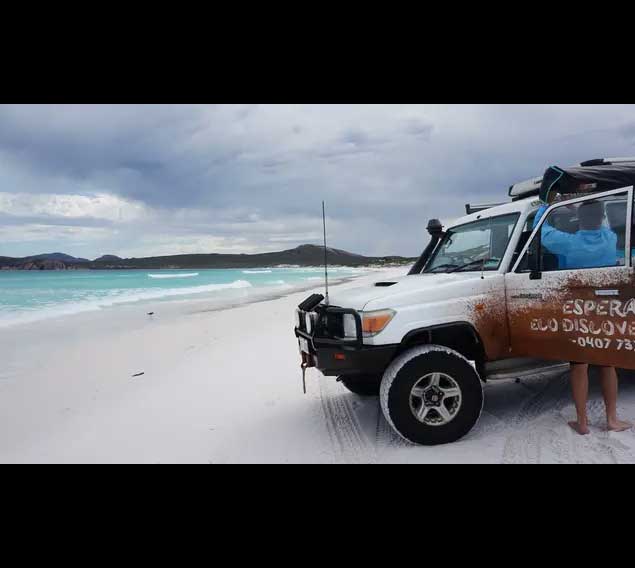The beauty of Lucky Bay, the sunniest and whitest sandy Kangaroo Beach in Australia – The Australian public is currently obsessed with Lucky Bay, a remote beach within the Cape Le Grand national park area. Not just any beach, this location offers various rare wonders in one place.
Lucky Bay is one of the few beaches in Australia where visitors can interact directly with a herd of kangaroos, who often relax on the white sand in the afternoon.
This remote location is also one of the best locations in the world to witness the whale migration in winter, which takes place between June and August. Interestingly, you don’t need to take a boat out to sea to see it, but just from the beach.
However, more than that, one thing that makes Lucky Bay a topic of conversation among many people is because its sand beach is claimed to be the whitest in Australia, and possibly the world.
It’s not just a promotion, but this claim has been scientifically proven, even twice.
According to Mark Adamson, the tour operator who took Liputan6.com to explore Lucky Bay on the 2019 Australia Tourism Exchange (ATE) post-family agenda, the initiative to start a scientific assessment of the whiteness of beach sand began in 2006.
The research was led by Noel Schoknecht, a Swiss soil scientist who was interested in proving the claim of the state of New South Wales, Australia, that its Hellfire beach sand was the whitest in the world.
“Researchers then collected sand samples from a depth of 10 centimeters from the surface of the active zone, which is between sea water and sand dunes. Based on the results of observations, it was found that Lucky Bay beach sand was in first place, while Hellfire Bay was in fifth place,” explained Adamson .
The second and third positions, according to Adamson, are occupied by Hyams Beach in the state of New South Wales, and White Beach on Boracay Island, Philippines.
Successfully Defending Scientific Claims
This proof was again scientifically tested in a challenge several years later, when Whitehaven Beach in Queensland, Australia, challenged for the title of having the whitest beach sand in the world.
“This time, a more rigorous scientific approach was used, measuring the spectral reflectance in beach sand samples, and you know, the results were only slightly superior. Lucky Bay remains the whitest in the world,” said Adamson, pointing out the unique texture of the sand involved.
Adamson said the whiteness of a beach depends on the composition and size of the sand particles.
The whitest sand usually has fine grains of milky or opaque quartz and the absence of impurities. “But until you see the sand side by side, it’s hard to know which is the whitest,” says Adamson.
“Interestingly, wherever the whitest sandy beaches are, only Australia has the most, and these must be maintained properly,” he concluded.
Ecosystem Diversity at Cape Le Grand
As the largest state in the Land of the Kangaroos, Western Australia has a variety of unique ecosystems that range from tropical areas in the north to those influenced by Antarctic climates in the south and southeast.
One of the most eye-catching is Cape Le Grand, a multi-diverse national park located in the Golden Outback, the second largest protected area in the Land of the Kangaroos, stretching from the outback to the southeast of the state of Western Australia.
Not only Lucky Bay, Cape Le Grand National Park also has a variety of other interesting natural tourist attractions, consisting of various different landscapes.
Located about an hour’s drive east of the town of Esperance, Cape Le Grand is accessible by all means of transport. However, for a more immersive experience, it is best explored in a 4×4, or four-wheel drive vehicle.
“By using a 4×4 vehicle, we can explore the diversity of the Cape Le Grand ecosystem, and also observe them directly one by one,” said Adamson.
For approximately four hours, Adamson invites tourists to experience the sensation of driving on a white sand beach almost 12 kilometers long. On this challenging journey, visitors can directly observe various coastal birds, bush ecosystems, and the blue sea water rolled by waves.
“If you come in winter (around June-August), you can witness the whale migration directly from the coast, it’s amazing,” added Adamson.
Up and Down Batu Mountain by Car
In addition to exploring the beach, this tour also invites visitors to drive through the bush area which contains various unique features, ranging from coastal springs, various herbal seeds, to several types of endemic reptiles.
After penetrating the bush, the journey continues into one of the few deserts in Australia which is filled with mounds of white sand. The views look surreal, where the various banks are bordered by bushes, large rocks, beaches, and some even touch directly with sea cliffs.
However, nothing is more thrilling than the final agenda, which is going up and down a rocky mountain using a 4×4 car. Every hard jolt passed by the tires makes the hearts of all passengers beat fast.
However, it all pays off when you reach the top of the rocky mountain, where visitors can access 360-degree views of the entire Cape Le Grand National Park area.
